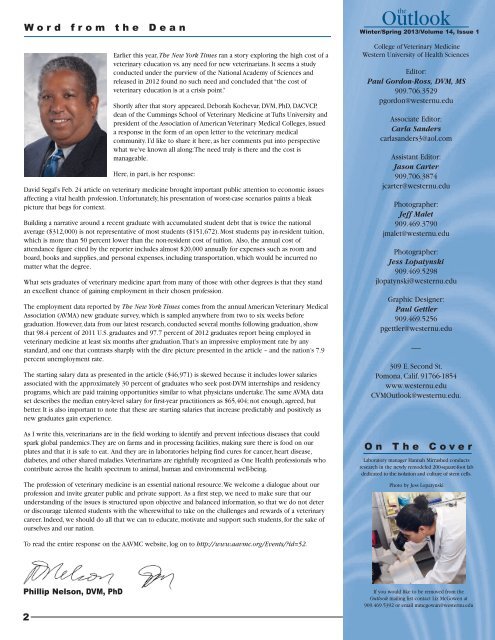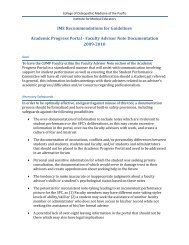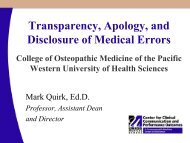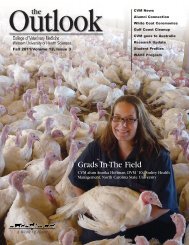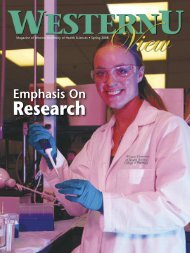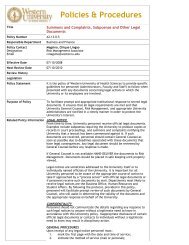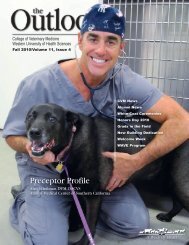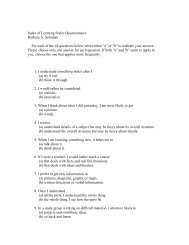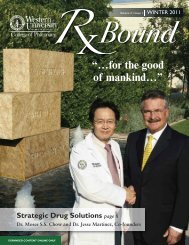Making Research a Priority - Western University of Health Sciences
Making Research a Priority - Western University of Health Sciences
Making Research a Priority - Western University of Health Sciences
You also want an ePaper? Increase the reach of your titles
YUMPU automatically turns print PDFs into web optimized ePapers that Google loves.
W o r d f r o m t h e D e a nEarlier this year, The New York Times ran a story exploring the high cost <strong>of</strong> aveterinary education vs. any need for new veterinarians. It seems a studyconducted under the purview <strong>of</strong> the National Academy <strong>of</strong> <strong>Sciences</strong> andreleased in 2012 found no such need and concluded that “the cost <strong>of</strong>veterinary education is at a crisis point.”Shortly after that story appeared, Deborah Kochevar, DVM, PhD, DACVCP,dean <strong>of</strong> the Cummings School <strong>of</strong> Veterinary Medicine at Tufts <strong>University</strong> andpresident <strong>of</strong> the Association <strong>of</strong> American Veterinary Medical Colleges, issueda response in the form <strong>of</strong> an open letter to the veterinary medicalcommunity. I’d like to share it here, as her comments put into perspectivewhat we’ve known all along: The need truly is there and the cost ismanageable.Here, in part, is her response:David Segal’s Feb. 24 article on veterinary medicine brought important public attention to economic issuesaffecting a vital health pr<strong>of</strong>ession. Unfortunately, his presentation <strong>of</strong> worst-case scenarios paints a bleakpicture that begs for context.Building a narrative around a recent graduate with accumulated student debt that is twice the nationalaverage ($312,000) is not representative <strong>of</strong> most students ($151,672). Most students pay in-resident tuition,which is more than 50 percent lower than the non-resident cost <strong>of</strong> tuition. Also, the annual cost <strong>of</strong>attendance figure cited by the reporter includes almost $20,000 annually for expenses such as room andboard, books and supplies, and personal expenses, including transportation, which would be incurred nomatter what the degree.What sets graduates <strong>of</strong> veterinary medicine apart from many <strong>of</strong> those with other degrees is that they standan excellent chance <strong>of</strong> gaining employment in their chosen pr<strong>of</strong>ession.The employment data reported by The New York Times comes from the annual American Veterinary MedicalAssociation (AVMA) new graduate survey, which is sampled anywhere from two to six weeks beforegraduation. However, data from our latest research, conducted several months following graduation, showthat 98.4 percent <strong>of</strong> 2011 U.S. graduates and 97.7 percent <strong>of</strong> 2012 graduates report being employed inveterinary medicine at least six months after graduation. That’s an impressive employment rate by anystandard, and one that contrasts sharply with the dire picture presented in the article – and the nation’s 7.9percent unemployment rate.The starting salary data as presented in the article ($46,971) is skewed because it includes lower salariesassociated with the approximately 30 percent <strong>of</strong> graduates who seek post-DVM internships and residencyprograms, which are paid training opportunities similar to what physicians undertake. The same AVMA dataset describes the median entry-level salary for first-year practitioners as $65,404; not enough, agreed, butbetter. It is also important to note that these are starting salaries that increase predictably and positively asnew graduates gain experience.As I write this, veterinarians are in the field working to identify and prevent infectious diseases that couldspark global pandemics. They are on farms and in processing facilities, making sure there is food on ourplates and that it is safe to eat. And they are in laboratories helping find cures for cancer, heart disease,diabetes, and other shared maladies. Veterinarians are rightfully recognized as One <strong>Health</strong> pr<strong>of</strong>essionals whocontribute across the health spectrum to animal, human and environmental well-being.The pr<strong>of</strong>ession <strong>of</strong> veterinary medicine is an essential national resource. We welcome a dialogue about ourpr<strong>of</strong>ession and invite greater public and private support. As a first step, we need to make sure that ourunderstanding <strong>of</strong> the issues is structured upon objective and balanced information, so that we do not deteror discourage talented students with the wherewithal to take on the challenges and rewards <strong>of</strong> a veterinarycareer. Indeed, we should do all that we can to educate, motivate and support such students, for the sake <strong>of</strong>ourselves and our nation.theOutlookWinter/Spring 2013/Volume 14, Issue 1College <strong>of</strong> Veterinary Medicine<strong>Western</strong> <strong>University</strong> <strong>of</strong> <strong>Health</strong> <strong>Sciences</strong>Editor:Paul Gordon-Ross, DVM, MS909.706.3529pgordon@westernu.eduAssociate Editor:Carla Sanderscarlasanders3@aol.comAssistant Editor:Jason Carter909.706.3874jcarter@westernu.eduPhotographer:Jeff Malet909.469.3790jmalet@westernu.eduPhotographer:Jess Lopatynski909.469.5298jlopatynski@westernu.eduGraphic Designer:Paul Gettler909.469.5256pgettler@westernu.edu------309 E. Second St.Pomona, Calif. 91766-1854www.westernu.eduCVMOutlook@westernu.edu.O n T h e C o v e rLaboratory manager Hannah Mirrashed conductsresearch in the newly remodeled 200-square-foot labdedicated to the isolation and culture <strong>of</strong> stem cells.Photo by Jess LopatynskiTo read the entire response on the AAVMC website, log on to http://www.aavmc.org/Events/?id=52.Phillip Nelson, DVM, PhD2If you would like to be removed from theOutlook mailing list contact Liz McGowen at909.469.5392 or email mmcgowan@westernu.edu


